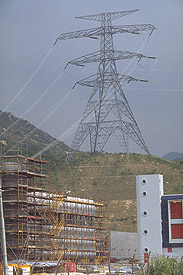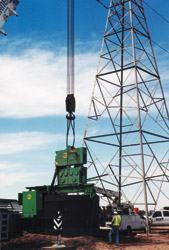Rip Van Winkle has nothing on the U.S. electric-transmission industry, which has slept for nearly two decades while market restructuring changed the world around it. Now, it's waking up after years of underinvestment, and engineers and constructors are scrambling to prepare for new construction on a scale not seen since the 1970s.
Many see the demand coming, but they hesitate to say when it will hit. Few utilities are building more than "Band-Aid-type projects," says Abraham Pichardo, a high-voltage specialist recently hired by Edwards & Kelcey Inc., Morristown, N.J., in anticipation of the boom. "The business has been a little slow," but that could change "suddenly," he adds.
"There will be a sizable volume in the next five years," agrees Michael Cooper, Laverne, Calif.-based regional manager for MYR Group Inc. He expects serious shortages of skilled labor and notes that the industry's culture also has changed. Where once whole families moved with the crews from project to project, "those crews have since been dispersed," he says. He doubts families today will do that.
 |
| DEMANDING New powerplants are taxing line capacity. (Photo courtesy of Parsons Brinkerhoff) |
Finding specialized equipment will be another likely challenge, says Cooper. Tools and equipment are coming out of mothballs and being modified for heavier lines–345-kv and 500-kv, rather than the 115-kv and 230-kv lines that were the norm, he says. MYR recently established a transmission fleet department to manage an expanded inventory of tools and equipment.
But deregulation's uneven pace makes utilities reluctant to invest in transmission, says Fred Haag, senior vice president of Quanta Services Inc., Houston. Their reduced role in generation is another factor. "Utilities don't have the revenue stream they had in the past," he notes. And some have deferred maintenance for so long while waiting for the picture to clear up that what would have gone to capital investment now has to be redirected to maintenance, he adds.
Utilities are looking for ways to increase existing line capacity rather than build new lines, says Rich Tangel, Edwards & Kelcey executive vice president. Using data from new environment-monitoring technologies, they can more precisely figure how much current they can push through existing lines, he says.
 |
| LIVE WIRE New construction will require revival of old labor skills. |
They are constructing high-voltage dc (HVDC) lines, too. Using only two conductors, HVDC can get more circuits on existing towers, Tangel says.
Reconductoring with new, higher-capacity wire and doubling circuits on single-circuit lines also are common, says Walt Womack, vice president at Burns & McDonnell, Kansas City. Older lines' towers, built before computers were widely available, were substantially stronger than necessary, he says. But computers have made it possible to determine more precisely how much unused tower strength is available, and lines are being modified to use more of the margin.
 |
| RIGGED Line work demands skills in heavy rigging. (Photo courtesy of the IRBY Construction Co.) |
"Once the need [for a new line] is recognized, NIMBY (Not-In-My-Back-Yard) becomes your biggest challenge," says Womack. On a recent project in south Texas, community resistance was strong. "They're real particular about what the line looks like and where it goes," he says.
Labor skills were lost when demand for them grew slack. MYR's Cooper notes that transmission construction requires skills in heavy rigging and hydraulic tools to a greater degree than other types of construction. Anticipating a shortage of skilled labor, MYR is actively recruiting through high schools and trade schools. But an initiative by the California-Nevada Line Apprenticeship, Riverside, Calif., attracted quite a bit of interest and the program may soon go national.
For $2,000, Cal-Nevada Director Armando Mendez placed a 60-second ad video on the Direct-TV Outdoor Channel for four weekends starting Jan. 27, 2002. The message was that apprentices could earn money while learning a well-paid trade and working outdoors, says Mendez. More than 350 people nationwide called the Cal-Nevada telephone number in the ad, he says. Most were directed to a corresponding local center of the National Joint Apprenticeship Training Program, of which Cal-Nevada is one. When the counting was done, Cal-Nevada reaped less than a dozen inquiries from its area. Some others received as many as 70, he says.
The results impressed officials in the Outside Construction Division of the National Joint Apprenticeship Training Committee, sponsored by the International Brotherhood of Electrical Workers and the National Electrical Contractors Association. Directors of other training centers have expressed interest in sharing costs to run the ads year-round, and it will be a topic of discussion at a mid-June division meeting in Oregon, says Mendez.
Quanta's Haag is moving in another direction and bringing in foreign nationals. Quanta has picked up some linemen from major transmission projects recently completed in Indonesia and the Philippines, and is investing as much as a year each to arrange for them to come to the U.S.
The supply of professional staff has shrunk, too. "Transmission line design engineers are hard to find," says Burns & McDonnell's Womack. "The electrical curriculum got away from power systems decades ago and never got back to it. We're hiring young civil-structural engineers and making them line designers," but achieving full-fledged competence takes four years, he says.
Haag expects to see plenty of construction using helicopters, which allow access to difficult sites without right-of-way wear and tear. A few big contractors will quickly lock up the market's available supply of other major equipment and absorb its capacity, he says.
 |
| ADD-ON Substation upgrades can postpone need for new lines. (Photo courtesy of Parsons Brinkerhoff) |
Contract forms also are changing. "We're looking at build-finance schemes now with extended payback," says Haag. Under such an arrangement, Quanta would take responsibility for engineering, procurement and construction, finance the construction and delay payment on projects up to $100 million, he says. Quanta also is willing to own and operate the completed line.
The Bonneville Power Administration, Portland, Ore., is experimenting with contracts for transmission work. BPA recently awarded 155 miles of line in three major transmission projects to Duke Energy, Charlotte, N.C., under a five-year, $182-million, furnish-and-install contract (ENR 4/29 p. 17).
The awakening industry also is finding changes in materials. Edwards & Kelcey's Pichardo says most lines built today use fiber-optic-on-steel conductor, for example, combining the functions of transmission, protection and telecommuni-cation. The conductor, called optical ground wire (OPGW) or fiber-optic ground (FOG), does not require an overhead shield wire, so it saves on labor.
Polymer insulators also are a recent innovation, says Pichardo. Self-cleaning, they improve line performance and reduce flashover. They are lighter than porcelain insulators and easier to install. They also are less satisfying to vandals prone to roadside target practice, because bullets just pass through the material, he adds.

Post a comment to this article
Report Abusive Comment